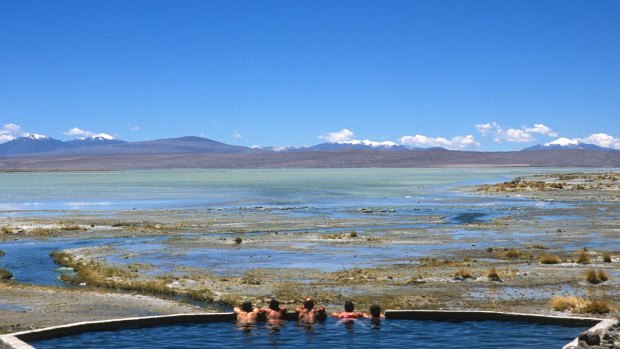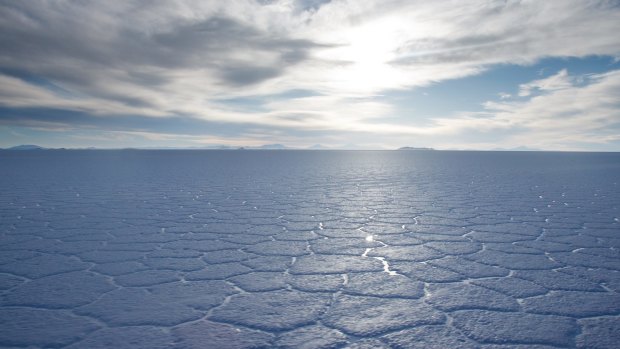This was published 7 years ago
The wild, weird and unadulterated country no one talks about

Tourists relax in the thermal pools in the Bolivian Altiplano.Credit: Getty Images
Make sure you get a window seat. Because as amazing as Bolivia is, as exciting and exotic and strange as this country will reveal itself to be once you're on the ground, there's no better introduction to it than the sight of La Paz from an aeroplane window.
Look down. The Andean altiplano is flat and featureless for miles on approach, but suddenly it splits open into a deep ravine, a valley that funnels down towards the base of jagged snow-capped peaks on the far horizon.
It takes a while to realise that all sides of that ravine are covered in houses – shabby brick structures that begin right at the lip of the altiplano and tumble down to the valley floor. There are high-rise buildings down there too. There are brightly painted buses on the roads that connect them; cars blocking every spare inch of bitumen; people rushing up and down the steep inclines.

The Salar de Uyuni in Bolivia is the biggest salt flat in the world. During the dry season, the dry cracked salt on the ground forms patterns.Credit: Getty Images
You catch a small flash of this as the plane banks and makes its way towards the runway at La Paz airport. And then you're in Bolivia.
Ask someone to name the highlights of South America and they'll quickly rattle off the cliches. There's Machu Picchu and the Inca Trail in Peru. There's Sugarloaf Mountain and Copacabana in Rio, the Amazon jungle, the Euro charm of Buenos Aires, the rugged beauty of Patagonia.
But no one mentions Bolivia. That is, until they go there.
Bolivia is the little South American country that could. It's the unlikely highlight of so many travellers' journeys, the wildest, weirdest and most unadulterated version of what a South American adventure can be.
There are very few cultural touchstones that you would recognise in Bolivia. More than 60 per cent of country's citizens are indigenous, and the influence of the West is limited to a few colonial-era cities and some recycled American buses.
The rest is Bolivians marching to the beat of their own drum. Their president, Evo Morales, is a former coca farmer. There's a prison in La Paz, made famous by the book Marching Powder, in which entire families live and come and go as they please.
Women still wear bowler hats and woollen shawls. There's a church in the town of Copacobana that people visit to have their new cars blessed because they say it's cheaper than buying insurance. There are witchdoctors who still sell their wares at markets. There seem to be constant marches on city streets in either protest or celebration – sometimes it's hard to tell which.
Bolivia is unlike any other country in South America, which is perhaps what makes it so great. This is the experience people are looking for when they visit this continent: a place that feels so different from the rest of the world.
Not everything is great. The food in Bolivia is average. The beer is almost undrinkable. And the standards of accommodation and road safety are not high.
And yet, you still want to go to Bolivia.
La Paz is the perfect jumping off point. It's big and it's busy and it's strange. Its streets are choked with traffic 24 hours a day. It's charmless in some ways, fascinating in others.
Shady characters call to you from dark corners. Witchdoctors peddle trinkets for good luck and bad. Street vendors sell food. Everyone is in a hurry. It's bizarre and fascinating.
See also: South America: All the must-do experiences
Tourists come here to cycle the Death Road, the mountain track that clings to a cliffside nearby and has brought about the undoing of countless commuters in the past. They also come here to scale one of the nearby snowy peaks, or to just relax and get acclimatised to the altitude, and the attitude.
There's more to the country than its capital (though La Paz, confusingly, is only the administrative capital, while Sucre is the legal capital). In the far west lies Lake Titicaca, and the town of Copacabana, from which the famous Brazilian beach takes its name. In the south there's Salar du Uyuni, the world's largest salt lake, a huge expanse of blinding white that enables locals to mine salt and tourists to take hilarious photos that play with the lack of depth perception on its wide, featureless terrain.
There's the sub-Andean city of Cochabamba, a friendly, easygoing place with the best cuisine in the country. And there are vast tracts of Amazon jungle in the lowlands to the east, places where travellers can get their fill of wildlife viewing without all of the tourists.
It's wild down there in the Amazon – but still, you'd have to say, not as wild as it is up in La Paz. And this you will know after even the smallest glance from an aeroplane window.
Email: b.groundwater@fairfaxmedia.com.au
Instagram: instagram.com/bengroundwater
See also: Queensland - more than just bogans
See also: The 13 best cities you've never been to
Sign up for the Traveller Deals newsletter
Get exclusive travel deals delivered straight to your inbox. Sign up now.